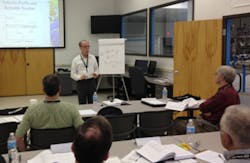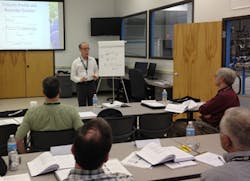This week I'm sitting in on David W. Spitzer's Industrial Flow Measurement Seminar, which is being presented at Endress+Hauser's state-of-the-art Process Training Unit near Philadelphia. David, as most of you know, is a regular contributor to Flow Control magazine and a renowned expert on all things flow measurement. Over the next three day's I'll report some interesting tidbits and lessons I've picked up at David's seminar. So without further ado, I present you with the first installment of "5 Things I Learned" from the Industrial Flow Measurement Seminar.
1. While David's primary focus during the seminar is flow measurement specifically, he covers a range of related topics with aim of increasing overal productivity. Along that line, he made the point that when you factor installation into the cost of pipe, the price point for stainless steel may be equal to, or better than, that of carbon steel pipe. For example, Schedule 10 stainless steel was used in one scenario because it was lighter and only required two people to install rather than three people to install. Also, another long-term cost of carbon steel pipe is the labor cost for the paint. Something to consider next time you're specifying pipe for a system.
2. In an existing flow measurement installation, how do you know the thickness of the pipe when there are no markings? Go back to the original drawings. You almost always don't know for sure what you have because there is nothing stamped on the outside of the pipe, but the original drawings can give you an idea of what you're dealing with. An ultrasonic thickness detector can also be helpful, and some clamp-on ultrasonic meters come outfitted with capability for determining pipe thickness.
3. Viscosity is important in flow measurement and it is very temperature dependent. Think of honey … Take honey out of the refrigerator and turn it upside down, nothing happens. Let it warm to room temperature, then turn upside down, it will slowly flow out. Heat it up to 50 C and turn the jar upside down, and it will flow pretty freely.
4. Reynolds Number is the relationship between viscosity, the inside pipe diameter, flowrate, and specific gravity. Or, said another way, Reynolds Number is the ratio of the inertial forces and the viscous forces in a flowstream. Some flowmeters are more affected by Reynolds Number than others. Laminar flow means the molecules flow in a straight line in the pipe. With turbulent flow, the molecules move around inside the pipe. In transitional flow, some molecules flow in a straight line, while others move around. Transitional flow can be problematic for many flowmeters.
5. When measuring flow, you typically want a good velocity profile. Obstructions in the piping system can distort the velocity profile. Some will say you need straight run to get a good velocity profile, but this is not the only way to do so. Likewise, the velocity profile can remain distorted for longer than the typically recommended 10x or 20x pipe diameter. Nevertheless, straight run is important, and upstream straight run is usually more important than downstream straight run. As such, don't put your flowmeter in the middle of a length of straight run, put it farther downstream to make sure the velocity profile is better. Similarly, don't put a control valve upstream of your flowmeter.
RELATED:
Day 3: 5 Things I Learned at the Industrial Flow Measurement Seminar
Day 2: 5 Things I Learned at the Industrial Flow Measurement Seminar
For links to David W. Spitzer's recent contributions to Flow Control magazine, click here. For more information on training opportunities through Endress+Hauser's Process Training University, click here.



